Practice Leader, Relationship Marketing, Customer Experience
Design a series of welcome emails to maximize subscriber engagement and retention
Practice Leader, Relationship Marketing, Customer Experience
In the vast domain of customer experience, welcome emails occupy an important place when it comes to ensuring engagement and retention of new subscribers, prospects and customers.
Neglected by almost half of businesses, the welcome journey plays an essential role in providing information, developing personalized relationships and increasing conversions.
In this article, we’ll provide a summary of the key elements for a successful welcome email series.
Summary:
- The importance of the welcome journey to customer experience
- Make a good first impression and strengthen your brand image
- Educate customers on your offers and services and help them achieve their objectives
- Promote engagement and reduce customer attrition
- Offer a personalized experience
- Collect customer data
- Key factors for a successful welcome strategy
- Design a simple acquisition journey for customers while collecting data for personalization
- Getting to know your customers and understanding them
- Efficiently manage the experience offered
-
In closing
The importance of the welcome journey to customer experience
To satisfy your customers and earn their loyalty, companies absolutely must guarantee a pleasant experience at every point of contact with the brand. This is why customer experience management is vital for gaining loyalty. In this field, the welcome journey has several important roles to play in the customer experience, acting as a catalyst for engagement, satisfaction and loyalty. Depending on the context and your marketing ecosystem, the welcome journey may include a number of channels (online and offline) and last from a few minutes to a few hours, or even several weeks. For this article, we’ll focus on welcome journey emails.
In addition to usually coming in second place when it comes to automated email series that generate the most revenue, the welcome series is one of the programs that generate the most opens and clicks. But its impact extends well beyond its performance. Keep reading to learn how welcome emails can generate value for your company and your customers.
Make a good first impression and strengthen your brand image
The welcome journey is often the first significant point of contact between a customer and a brand. Since the first impression is such a determining factor, a well-conceived series of welcome emails sets the tone for a positive and lasting relationship. This moment in the customer relationship also represents a very interesting opportunity to introduce customers to the mission and values of the business and thereby strengthen its positioning. When well executed, the welcome journey strategy lets you create an emotional connection, which is essential for developing customer loyalty towards the brand from the very start of the relationship.
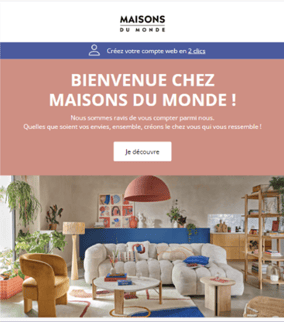
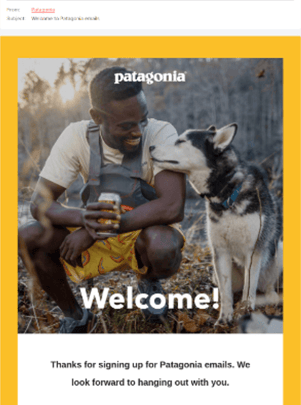
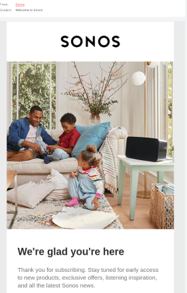
Educate customers on your offers and services and help them achieve their objectives
There are several types of welcome journey, depending on what the company would like their customers to achieve. One of the main goals of the welcome journey is to inform and educate customers about the brand, and its products or services, so that they can take advantage of it to the fullest extent.
By providing useful information from the beginning, the welcome journey helps customers better understand your offer, reduce barriers to purchasing and orient them towards products or solutions that fulfill their needs. The journey could, for example, introduce the company’s categories of products and services, present how the loyalty program works, guide customers in how to use a complex product or service, etc.
Examples: Here, French furniture brand Maison du Monde offers customers the possibility to explore inspiring content, and IKEA explains the advantages of being a member of the IKEA Family.
.
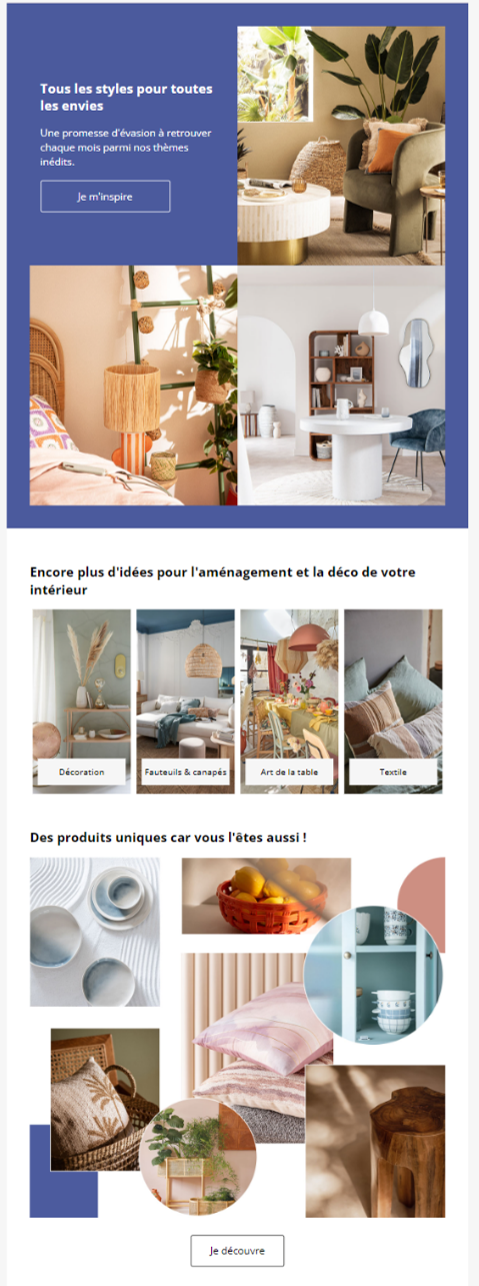

The welcome journey can also accelerate the conversion process by efficiently guiding prospects through the sales funnel, from awareness through to the decision to purchase. One of the value propositions often found in the welcome journey is a discount offer towards a first purchase.
Example: Simons offers a $10 discount on a customer’s first $100 purchase.
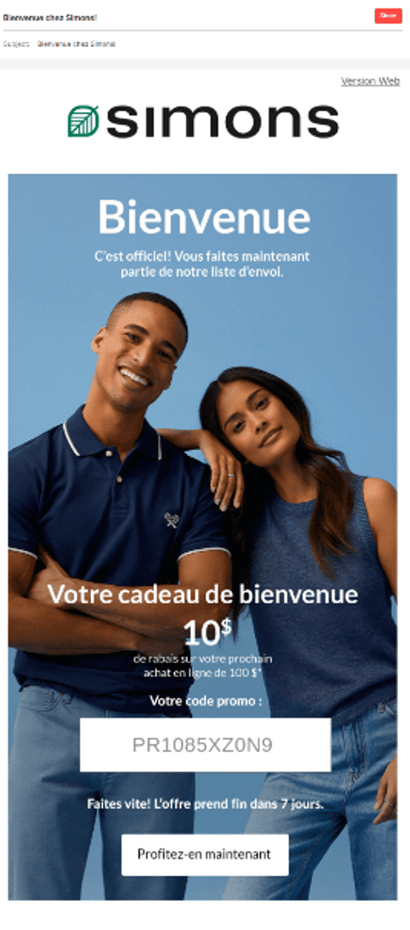
Promote engagement and reduce customer attrition
An engaging welcome journey encourages customers to interact more with the brand. Based on their objectives, this could mean exploring additional content promoting consideration of the brand’s products or services, participating in or joining a loyalty program, following the brand on social media or even using a service or application. By providing a positive, engaging customer experience from the very start, the welcome journey can thereby help reduce the attrition rate—customers who feel valued and well informed are less likely to disengage or look for alternatives amongst competitors.
Example: In the welcome email from Ashley Canada, subscribers are immediately invited to follow the brand on its social media accounts where it shares trends, decorating tips and new developments.
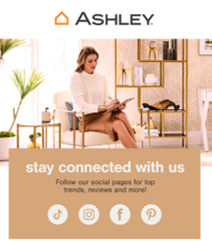
Offer a personalized experience
By adapting the welcome journey to the specific needs and interests of each customer, brands can offer a more personalized, relevant experience, thereby increasing engagement and satisfaction.
To this end, it’s crucial to collect data about customers beforehand, meaning whenever forms are being submitted, whether these are purchase forms, subscription forms for newsletters, forms to download guides or forms to request a demonstration.
The first and main use case for personalization in welcome emails is the insertion of profile fields, such as first name (and name of the company for B2B), blocks with product suggestions and categories, information from members’ accounts for welcome emails to loyalty programs, and even store locations that are close by.
Collect customer data
Finally, the welcome journey offers an often underexploited opportunity to collect important customer data that can be used to refine marketing strategies as well as the overall customer experience. At this stage of the relationship, customers are often highly likely to share data, such as their preferences and attitudes to products and services, in the hopes that the brand will better fulfill their expectations.
Example: In the welcome email sequence, retailer Ashley encourages its customers to complete their profile to take advantage of a personalized experience.
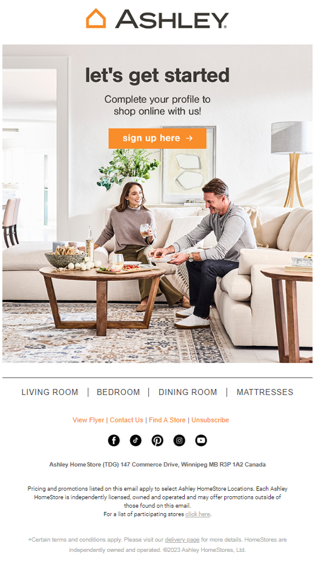
Key factors for a successful welcome strategy
Design a simple acquisition journey for customers while collecting data for personalizationTo promote the acquisition of subscribers and primary data, it’s important to:
-
Offer exchange value starting from sign-up and right through the customer life cycle. The customer journey is full of opportunities to acquire subscribers. Incentives to subscribe notably include access to promotional offers, the opportunity to be informed on the latest news about the brand, as well as access to educational or inspiring content.
-
Limit the number of fields to be completed manually in sign-up forms. One best practice to follow for email subscription forms is to limit them to three fields.
-
Opt for forms with interactive fields, if your technological capacities allow it, especially for multiple-choice questions, such as preferences and user interests. This not only makes sign-up easier for users, but also enables better personalization of the experience from the start of the relationship.
-
Use multi-step forms effectively. This is an especially wise practice when asking for more information from your subscribers (while ensuring you first collect their email address)
-
Exploit behavioural primary data collected when users are browsing your site (such as categories and products viewed), which lets you personalize their experience to a significant extent, at least as far as your privacy policy and the integration of your consent management platform with your email system will allow (and obviously so long as your subscribers have consented to this use). This precious information can guide what product and service recommendations you provide to match the interests of each subscriber.
For more information on acquiring subscribers and customer data, you can view our guide here: Improving Customer Retention Through Sustainable Audiences.
Getting to know your customers and understanding them
To effectively adapt the welcome journey to your customers, you should ideally start off with a deep understanding of them. This involves drawing on various sources of data in order to improve your understanding of your customers’ needs, behaviours and preferences. Before defining the specifics of the content of your welcome journey, here are a few relevant questions to ask yourself when doing research:
-
What demographic, behavioural and transaction characteristics best describe your most engaged and important customers?
-
What are your customers’ main goals and expectations when they engage with your brand?
-
What are the main areas of friction or obstacles your customers encounter in their current journey?
-
What type of content or offer resonates most with these people?
To answer these questions, several sources of data need to be exploited, such as market studies, consumer analyses and even industry reports. You can also rely on all the centralized knowledge available within your organization. You should particularly consider your internal documentation (marketing performance reports and customer service feedback reports) or even analytics platforms, such as GA4 or your customer data platforms (CRM, CDP, etc.). To this end, Adviso can help you uncover these insights, which will generate the most value depending on your objectives, using proven research methodologies and data analysis products.
By relying on these diverse sources of data, you can refine your welcome journey strategy by making it more adapted to and personalized for the actual needs of your customers. This approach based on data will let you not only better understand your customers, but also define clearer goals for your welcome journey, thereby ensuring an improved and more engaged customer experience.
Efficiently manage the experience offered
As opposed to a standard newsletter, which may address a large audience with a more general message, the welcome series is launched by a specific action taken by the subscriber. This particularity makes the personalization and relevance of your messages even more crucial, and several elements need to be considered to effectively plan the experience.
-
The trigger: It’s essential to understand exactly what action drove the subscriber to receive this email. Was it a purchase, a sign-up for a newsletter, a content download or another specific interaction? This knowledge will let you contextualize the messages and make the trigger directly relevant to the subscriber.
-
Brand history: Keep in mind that the history of interactions the subscriber has with your brand on various channels will hugely enrich customer experience during the discovery phase. A new subscriber who made a purchase has a different profile than someone who simply signed up to receive information. Each journey deserves a personalized approach based on past interactions, whether you know what those are specifically or can infer them. The more interactions with your sales and marketing channels are integrated into a 360 view of your customers, the more the experience you offer can be made personal and relevant.
-
The desired goal after subscription: Determining what you would like the subscriber to do after receiving the welcome email is critical. Do you want to encourage a first or second purchase, get them to follow your brand on social media or obtain additional information to refine future personalization? The clarity of this goal will influence the design of your message and the call to action.
-
The number of emails in the series: There’s no one formula for determining the number of emails to send in a welcome series, but we notice that most brands use between three and five emails. But while there is no universal model, most brands opt for series that include an initial introduction to the brand, a second email that introduces its products/services and a third email sharing notices for customers, key elements to provide reassurance, etc. Following the welcome series, subscribers can access the newsletter archives or wait until they fulfill the conditions to receive other automated messages that are part of the customer journey.
-
Application of best practices in emailing: Ensure you are using clear, clean design for your emails, prioritizing the use of high-quality images and offering attractive incentives, such as discounts or special offers, to encourage engagement from the very first contact. For tips on best practices in email design, take a look at our article on the subject.
-
Content maintenance: Whether there are blocks of content in your emails or you are redirecting subscribers to content, it’s important to anticipate frequent revisions to your content (annually at minimum) so that they remain relevant. By using evergreen content, you’ll limit the need for maintenance and thereby promote an optimal experience. However, this isn’t always possible (for example, in the fashion industry or in tourism, given the extreme seasonality of the information). It’s therefore preferable to plan from the outset some simple, well-documented processes for maintaining this content with minimal effort.
In closing
Designing a welcome journey adapted to the expectations of customers is essential for attracting and keeping them, starting from the first interaction. By carefully planning the execution, companies can significantly increase engagement, satisfaction and, ultimately, loyalty towards their brand. A map of the customer journey and a plan for automating emails will be particularly useful when collaborating with the various teams involved in this type of project and for ensuring its success.
If you would like to develop your welcome journey, don’t hesitate to get in touch with us. Our team would be happy to evaluate your needs and offer and approach adapted to your particular situation.

%20(1)-1.jpg)











